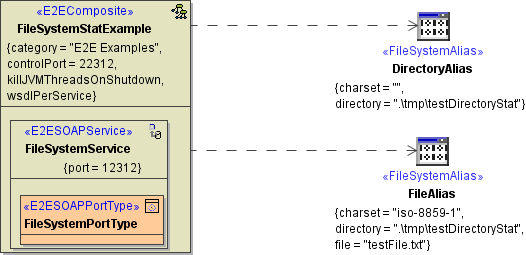Page History
Versions Compared
Key
- This line was added.
- This line was removed.
- Formatting was changed.
| Hint_designer | ||||
|---|---|---|---|---|
|
Figure: File System Component Diagram

The alias FileAlias represents a certain file, the alias DirectoryAlias represents a certain directory on the file system. On both you can use relative paths - they will be relative to the service directory on the E2E Bridge, then.
The directory alias can define a base directory and a default file encoding:
- The default file encoding can be overridden per adapter call using a dynamic encoding parameter, e.g. on File System Adapter calls reading lines, or with the Flat File Adapter.
- Regarding the base directory, the file name parameter will be treated as a path relative to this directory on the File System Adapter call. Jumping out of the base directory by
../../aDirectorytricks is impossible. The base directory can be changed in the service settings on the E2E Bridge, however.
See also Directory Alias and Dynamic File Access for an example of using the directory alias with dynamic file access.
Using a file resource, neither file encoding nor file path can be overridden.
Tagged Values
<<DirectoryAlias>>
| Multiexcerpt include | ||||
|---|---|---|---|---|
|
<<FileAlias>>
| Multiexcerpt include | ||||
|---|---|---|---|---|
|
File System Components of Builder Version 6
Deprecated since Builder 7
| Expand | ||||||||||||||||||||
|---|---|---|---|---|---|---|---|---|---|---|---|---|---|---|---|---|---|---|---|---|
| ||||||||||||||||||||
The use of file system access is represented by the two aliases DirectoryAlias and FileAlias. Both have the stereotype <<FileSystemAlias>>. They are connected to the service composite by a dependency. Figure: File System Component Diagram The alias FileAlias represents a certain file. It has three tagged values:
The alias DirectoryAlias represents a certain directory on the file system. Hence, only the tagged value directory has to be defined. Tagged Values of the <<FileSystemAlias>> In general, a <<FileSystemAlias>> can have four tagged values:
| ||||||||||||||||||||
| Otp | ||
|---|---|---|
|
| Rp |
|---|
